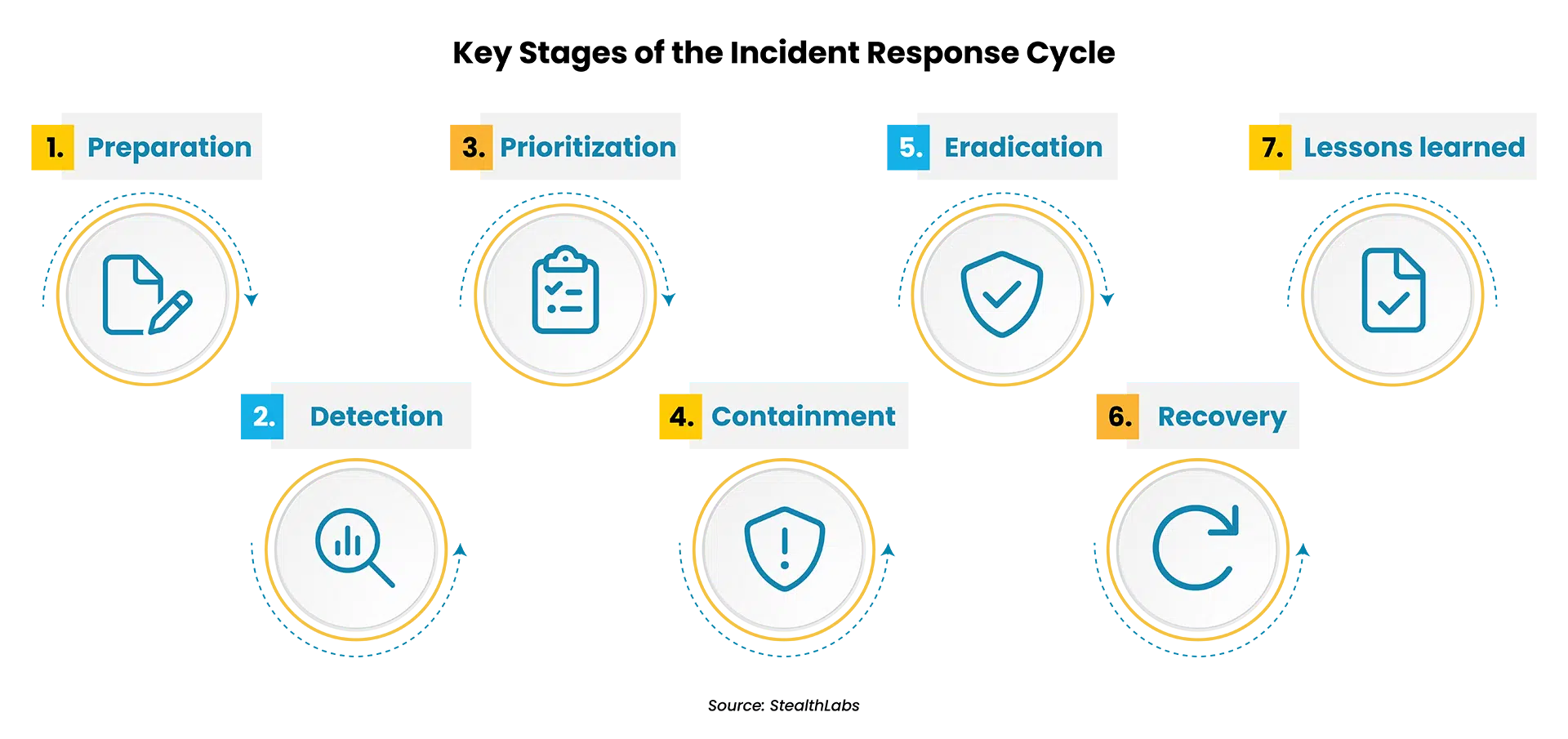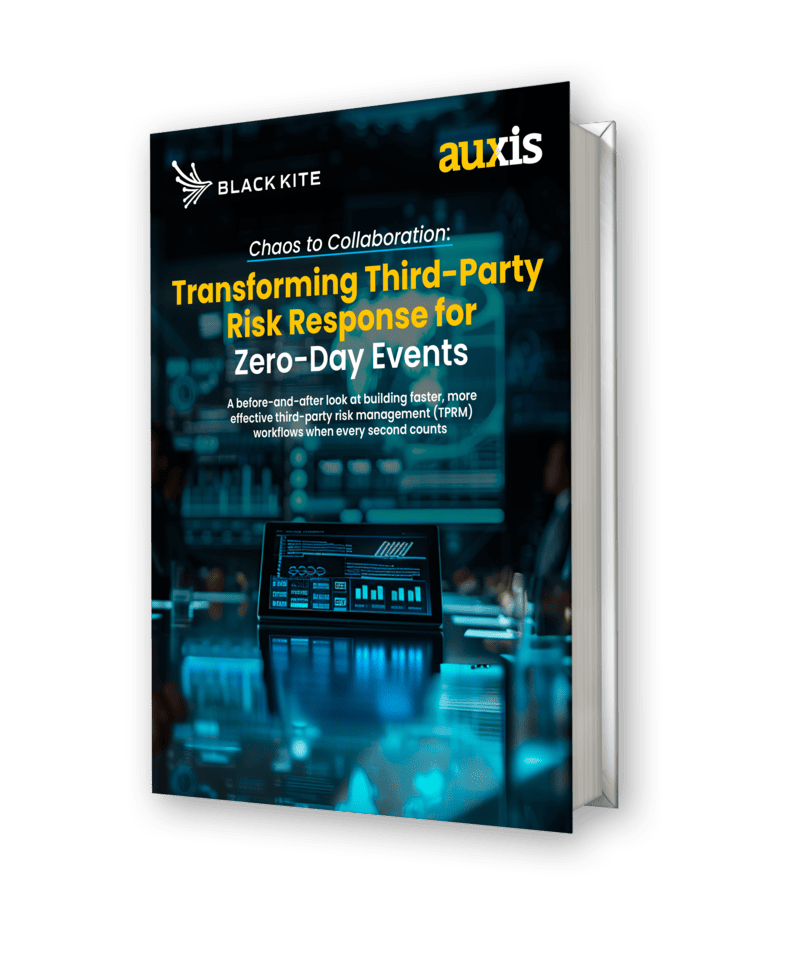In brief:
- With over 80% of organizations facing at least one cyberattack in the last 12 months, businesses must expand their strategy beyond preventing breaches to include effective responses.
- Internal security teams face overwhelming challenges, such as alert fatigue and too many false positive alerts, leading to poor prioritization and the risk of missing critical alerts.
- An effective incident response framework provides a comprehensive, well-structured methodology for quickly managing cyber incidents to minimize damage and reduce recovery time and cost.
- With AI driving the steep rise in attacks, every stage of an effective cybersecurity incident response framework must be enhanced by AI and automation to contain and mitigate threats effectively.
In today’s hyper-connected world, cyberattacks are no longer a matter of if – but when. More than 80% of organizations experienced at least one successful attack in the past year (CyberEdge Group 2024 Cyberthreat Defense Report). More than 70% suffered financial losses as a result (2024 Keeper Security Insight Report).
AI advancements and the proliferation of AI tools are making cyberattacks faster, cheaper, and more lethal: 87% of global organizations faced an AI-powered cyberattack in the past 12 months (SoSafe Cybercrime Trends 2025 Report). Generative AI tools and automation help hackers compose phishing emails up to 40% faster, for example – and prompt 78% of recipients to open them.
Behind each of these statistics lies a sobering reality: as cyberattacks become more of an inevitable event, scrambling to react every time your business faces a threat is no longer an option. Proactively building an incident response framework is key to controlling the consequences of a cyber incident – minimizing damage to systems and data, reducing recovery time and costs, and maintaining trust with your customers and stakeholders.
What is an incident response framework?
Incident response is the process of dealing with a security incident, defined as any event that compromises or threatens the security of an organization’s systems, data, or information. Security incidents can range from intentional cyberattacks by hackers to unintentional violations of IT security policy by legitimate authorized users.
The goal of incident management is to effectively manage incidents to minimize damage to systems and data, reduce recovery time and cost, and control damage to brand reputation. An incident response framework provides a comprehensive, structured methodology for implementing incident response effectively.
Having an incident response team and an effective response framework can help organizations reduce the cost of a breach by nearly $500,000 on average.
Source: IBM’S 2024 Cost of a Data Breach Report
What kinds of threats does a cybersecurity incident response framework protect against?
A comprehensive incident response framework helps organizations defend against a wide range of cyberthreats, including:
- Ransomware attacks
- Phishing and social engineering
- Malware infections
- Data breaches
- Unauthorized access
- Insider threats
- Denial of Service (DoS) attacks
- Advanced Persistent Threats (APTs)
What does a cybersecurity incident response framework typically include?
An effective incident response framework includes the following components:
- Incident response methods and strategies: Defined approaches for managing different types of security incidents.
- Alignment with organizational mission: How incident response supports your organization’s broader objectives and priorities.
- Stage-specific activities: Detailed procedures for each phase of incident response.
- Roles and responsibilities: Clear definition of who does what during an incident.
- Communication channels: Established methods for communication between the incident response team and other stakeholders.
- Evaluation metrics: Measurements to assess the efficiency and effectiveness of your incident response efforts.
Leveraging AI in incident response is vital as AI-driven attacks become more sophisticated and frequent. Automated incident response, which includes threat detection and mitigation, can detect unusual behavior faster and automatically isolate impacted systems – containing threats right away while alerting security teams about the containment measures taken.
For instance, organizations that leverage AI and automation extensively for proactive prevention experience 46% lower costs from a data breach than those that do not – a difference of more than $2.2 million, according to IBM’s 2024 Cost of a Data Breach Report.

Not surprisingly, 72% of organizations plan to integrate AI and machine learning into their cybersecurity frameworks this year to support more accurate threat detection and real-time intelligence, IBM’s report found.
AI-powered security systems can help with:
- Early detection of threats through behavioral analysis
- Automatic containment of potential breaches
- Reducing the overwhelming volume of security alerts
- Prioritizing which alerts require human attention
- Accelerating response times through automated workflows
The importance of incident response
The benefits of a robust incident response framework extend far beyond simply recovering from a breach. A well-designed plan enables organizations to:
1. Prepare for the known and unknown
By conducting regular drills and updating incident response plans, organizations build muscle memory to handle both known threats like ransomware and unanticipated ones like zero-day exploits. Unfortunately, only 30% of organizations regularly test their incident response plans, even though companies that conduct regular testing save an average of $1.49 million per breach, IBM’s Cost of a Data Breach report found.
2. Identify security incidents proactively
Quick identification is crucial for limiting damage. A structured incident response process includes AI-powered monitoring systems and procedures that help detect anomalies and potential security incidents as early as possible. Organizations using AI-powered security systems in 2024 detected and contained breaches 108 days faster, saving an average of $1.76 million per breach compared to those that don’t, IBM found.
3. Establish best practices to block intrusions
An incident response framework helps organizations develop and implement security controls and procedures that can prevent future attacks before they cause damage.
4. Minimize financial impact
The average cost of a data breach is $9.36 million in the U.S. – the highest of any country, IBM found. A proper data breach response plan helps minimize these costs by limiting the scope and impact of attacks.
5. Meet regulatory requirements
Many industries face strict compliance requirements regarding data protection and breach notification. An incident response framework helps ensure organizations meet these obligations.
6. Prevent reputational damage
Security breaches can severely damage an organization’s reputation. Some 70% of consumers said they would stop shopping with a brand after a security incident, underscoring the impact to customer loyalty and business revenue, a 2024 Vercara Consumer Trust & Risk report found.
Well-strategized incident response strategies help demonstrate to customers, partners, and stakeholders that your organization takes security seriously and is prepared to handle incidents professionally.
What does an effective data breach response plan look like?
Organizations can be at different places in their cybersecurity journey. Companies just starting out may benefit from basic security fine-tuning that takes the first steps toward improved cybersecurity posture, while larger organizations may benefit from more advanced strategies to address complex risks.
Generally, an effective incident response process includes seven key phases:

1. Preparation
Preparation is the most crucial phase of incident response, as it determines how well an organization will respond when an attack occurs. Key elements include:
- Policy development: Creating a written set of principles, rules, and practices that offer guidance on what constitutes an incident and how to respond.
- Incident response plan/strategy: Developing procedures for prioritizing incidents based on organizational impact, from minor incidents like a single workstation failure to high-risk issues like data theft.
- Communication planning: Establishing clear communication channels and protocols to ensure the right people are contacted at the right time.
- Documentation procedures: Setting up systems to document every aspect of incidents and responses to support learning and potential legal proceedings.
- Team formation: Building a cross-functional incident response team with representatives from IT, security, legal, communications, and business operations.
- Access control: Ensuring team members have appropriate permissions to respond to incidents while maintaining security.
- Tools and resources: Assembling the software, hardware, and other resources needed to investigate and respond to incidents.
- Training: Regular drills and exercises to ensure all team members understand their roles and responsibilities.
2. Early detection
This phase involves monitoring systems to detect potential security incidents and determining whether an actual incident has occurred. Key activities include:
- Monitoring security alerts from intrusion detection systems, firewalls, and other security tools
- Analyzing logs and security data to identify suspicious activities
- Reviewing error messages and system anomalies
- Collecting and correlating data from various sources to confirm incidents
The challenge of detection is significant. Security Operations Center (SOC) staff are overwhelmed by an average of 3,800+ alerts per day, with 62% ignored due to excessive workload and inefficiencies in security tools, a 2024 Vectra State of Threat Detection report states.
It’s easy to miss genuine threats amidst the noise – underscoring the need for automated threat detection, triage, and AI in incident response.
3. Prioritization
More than half of IT professionals spend more than 20% of their time deciding which alerts to deal with first (Orca Security Alert Fatigue Report). Even more concerning, 55% said their teams miss critical alerts due to ineffective prioritization, often on a weekly and even daily basis.
Having effective incident response processes to prioritize security issues is fundamental to protecting your business. Without proper prioritization, organizations struggle to allocate limited resources to the threats that matter most.
The prioritization phase involves:
- Assessing the scope and nature of the incident
- Determining potential impact on business operations, data, and systems
- Categorizing incidents based on severity and business impact
- Escalating and allocating resources appropriately based on priority
4. Containment and forensics
Once an incident is confirmed and prioritized, the focus shifts to containing the threat and gathering forensic evidence.
Containment includes:
- Short-term containment: Taking immediate actions to limit damage, such as isolating infected machines or taking down affected servers.
- System backup: Capturing forensic images of compromised systems to preserve evidence and understand the attack.
- Long-term containment: Implementing temporary fixes to allow systems to be used while permanent solutions are developed, including removing backdoors and applying security patches.
Forensics involves:
- Investigating how the attack occurred
- Identifying affected systems and data
- Determining what actions were taken by the attackers
- Collecting evidence that may be needed for legal purposes
These actions help you understand the attack’s origin, methods, and impact, which informs recovery and prevents future incidents.
5. Eradication
The eradication phase of incident response is critical for fully eliminating an attacker’s presence from the environment and ensuring they cannot regain access. This step involves removing malicious files and tools as well as identifying and addressing the root cause of the breach, such as patching exploited vulnerabilities and closing security gaps.
Skipping or rushing eradication can lead to persistent threats or reinfection, so thoroughness is essential for restoring system integrity and building stakeholder confidence. An alarming new trend in ransomware, for example, has been rapid-fire attacks in quick succession against the same business by different players – indicating threat actors are monitoring attacks and taking advantage of organizations when they are weak.
6. Recovery
This phase focuses on restoring normal operations while ensuring threats are not reintroduced into the environment:
- Rebuilding affected systems and restoring data from clean backups
- Applying security patches and addressing vulnerabilities
- Testing and validating that systems are clean and functioning properly
- Monitoring for any signs of continuing compromise
7. Lessons learned
After an incident is resolved, it’s essential to review post-incident activity and improve future response capabilities. Unfortunately, this is the phase many organizations overlook:
- Conducting a comprehensive analysis of the incident
- Assessing what went well and what could be improved
- Updating security controls, policies, and procedures
- Enhancing training and awareness programs
- Revising the incident response plan based on lessons learned
A thorough post-incident report should document when the problem was first detected, how, and by whom, the root cause of the incident, containment and eradication methods used, actions performed during recovery, strengths and weaknesses in the response, and recommendations for improvement.

Why businesses struggle with incident response
Despite the clear importance of effective incident response, many organizations struggle to implement and maintain robust capabilities. The number of organizations maintaining minimum viable cyber-resilience dropped 30% between 2023 and 2024, with 81% of organizations feeling more or as exposed to cybercrime than they did the previous year, according to a World Economic Forum cybersecurity report.
What are the key challenges they are facing?
1. Talent shortages
Cybersecurity professionals are in high demand and short supply: in the U.S. alone, Cybersecurity Ventures reports more than 750,000 cybersecurity job vacancies.
Only 14% of organizations are confident they have the cybersecurity talent and skills to adequately protect their organization.
Source: WEF Global Cybersecurity Outlook 2025
This makes it difficult for many organizations to build and maintain dedicated incident response teams, leaving them ill-equipped to handle the volume and complexity of security threats.
2. Alert fatigue
Security Operations Center (SOC) teams receive thousands of alerts daily – resulting in an average of 500 investigation-worthy endpoint security alerts alone every week, Cybereason’s latest survey found. These investigations consume a whopping 65% of analysts’ time.
False positives constitute another major inefficiency, incorrectly indicating alerts suggest a threat and wasting analysts’ precious time. Combined, these inefficiencies lead to alert fatigue, making it difficult to prioritize and respond effectively.
3. Security operations can’t keep up with AI-fueled attacks
AI is making cyberattacks faster, cheaper, and more lethal – leaving 97% of security professionals concerned that their organization is vulnerable to an AI-generated attack, states Deep Instinct’s 2024 AI in Cybersecurity report.
But while 75% have tried to adjust their cybersecurity strategy in the past year to fight back, most struggle to mount an appropriate response. The biggest stumbling blocks: lack of in-house AI and cybersecurity expertise, outdated security infrastructure, and process immaturity in their security operations.
Reluctance to trust AI capabilities in security operations is another key factor. While applying AI as a powerful addition to security workflows stands as this year’s highest cybersecurity priority, 61% of security professionals conversely said they only “somewhat trust” AI for mission-critical operations, Splunk’s State of Security 2025 report found.
4. Multiple priorities and limited budget
Internal IT teams juggle a wide range of responsibilities, often leaving incident response under-resourced and overlooked. With tight budgets and limited staffing, most organizations lack the dedicated personnel, tools, and 24/7 monitoring needed for effective threat detection and response.
This challenge is especially acute for small and mid-sized businesses. According to WEF’s 2025 Global Cybersecurity Outlook, over 70% of cybersecurity leaders believe these organizations can no longer effectively protect themselves against today’s increasingly complex cyberthreats.
Why Auxis: Scale security without scaling costs
The urgent need for coordinated incident response is clear. However, building and maintaining in-house capabilities is costly and resource-intensive — especially as cybersecurity grows more complex.
It’s no surprise that cybersecurity is now the #1 outsourced business function, alongside infrastructure services, with 77% of organizations turning to third-party providers to protect their organizations against today’s fast-evolving threats (Deloitte Global Outsourcing Survey 2024).
For businesses looking to enhance their security posture while controlling costs, a trusted Managed Security Services Provider (MSSP) like Auxis delivers the right mix of expertise, advanced tools, continuous monitoring, and well-structured incident response. Auxis takes the time to understand your specific business needs and industry requirements, providing services that align with your unique risk profile.
At the same time, its 24×7 Security Operations Center located in Latin America’s top tech markets offers cost-effective scalability – combining deep pools of top-tier cybersecurity talent with real-time communication, cultural alignment, and outstanding English proficiency that makes it easy to resolve urgent issues quickly and effectively.
With cyberattacks on the rise and IT teams stretched thin, an effective incident response plan implemented with the support of a top-quality managed security services partner offers the best protection against today’s evolving threats. By combining people, process, technology, and AI-led automation in a cost-effective model, Auxis helps ensure you’re ready to respond effectively when – not if – a security incident occurs.
Ready to strengthen your organization’s incident response capabilities? Schedule a consultation with our cybersecurity experts today! You can also visit our resource center for more IT security tips, strategies, and success stories.
Frequently Asked Questions
What is an incident response framework, and why is it critical for my organization?
How can automated incident response improve detection and resolution times?
Do small and medium-sized businesses need formal incident response plans?
What are some real-world incident response examples?
What are the most common mistakes organizations make with incident response?
What’s the ROI of investing in an incident response framework or service provider?




